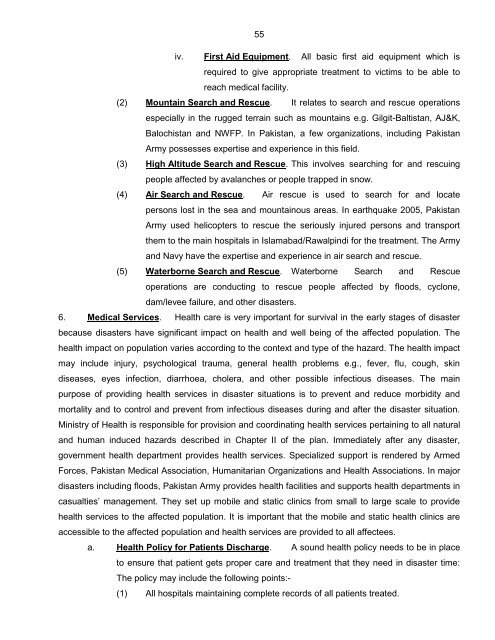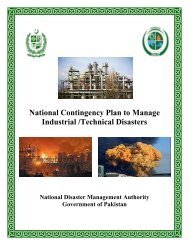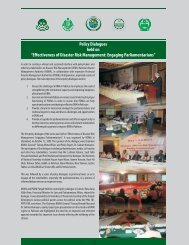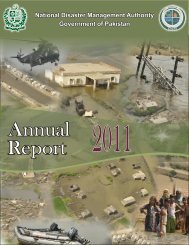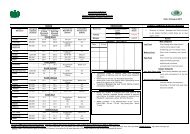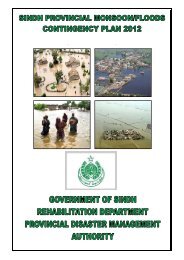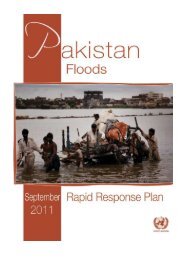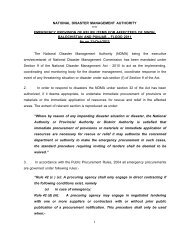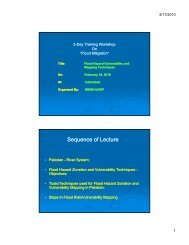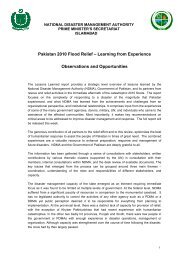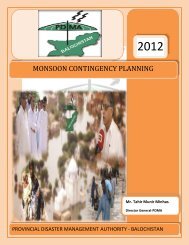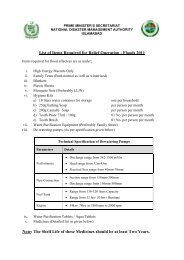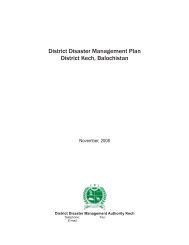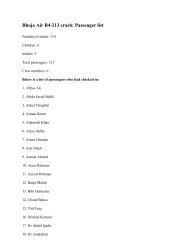National Disaster Response Plan (NDRP) March 2010 - NDMA
National Disaster Response Plan (NDRP) March 2010 - NDMA
National Disaster Response Plan (NDRP) March 2010 - NDMA
You also want an ePaper? Increase the reach of your titles
YUMPU automatically turns print PDFs into web optimized ePapers that Google loves.
55<br />
iv. First Aid Equipment. All basic first aid equipment which is<br />
required to give appropriate treatment to victims to be able to<br />
reach medical facility.<br />
(2) Mountain Search and Rescue. It relates to search and rescue operations<br />
especially in the rugged terrain such as mountains e.g. Gilgit-Baltistan, AJ&K,<br />
Balochistan and NWFP. In Pakistan, a few organizations, including Pakistan<br />
Army possesses expertise and experience in this field.<br />
(3) High Altitude Search and Rescue. This involves searching for and rescuing<br />
people affected by avalanches or people trapped in snow.<br />
(4) Air Search and Rescue. Air rescue is used to search for and locate<br />
persons lost in the sea and mountainous areas. In earthquake 2005, Pakistan<br />
Army used helicopters to rescue the seriously injured persons and transport<br />
them to the main hospitals in Islamabad/Rawalpindi for the treatment. The Army<br />
and Navy have the expertise and experience in air search and rescue.<br />
(5) Waterborne Search and Rescue. Waterborne Search and Rescue<br />
operations are conducting to rescue people affected by floods, cyclone,<br />
dam/levee failure, and other disasters.<br />
6. Medical Services. Health care is very important for survival in the early stages of disaster<br />
because disasters have significant impact on health and well being of the affected population. The<br />
health impact on population varies according to the context and type of the hazard. The health impact<br />
may include injury, psychological trauma, general health problems e.g., fever, flu, cough, skin<br />
diseases, eyes infection, diarrhoea, cholera, and other possible infectious diseases. The main<br />
purpose of providing health services in disaster situations is to prevent and reduce morbidity and<br />
mortality and to control and prevent from infectious diseases during and after the disaster situation.<br />
Ministry of Health is responsible for provision and coordinating health services pertaining to all natural<br />
and human induced hazards described in Chapter II of the plan. Immediately after any disaster,<br />
government health department provides health services. Specialized support is rendered by Armed<br />
Forces, Pakistan Medical Association, Humanitarian Organizations and Health Associations. In major<br />
disasters including floods, Pakistan Army provides health facilities and supports health departments in<br />
casualties‟ management. They set up mobile and static clinics from small to large scale to provide<br />
health services to the affected population. It is important that the mobile and static health clinics are<br />
accessible to the affected population and health services are provided to all affectees.<br />
a. Health Policy for Patients Discharge. A sound health policy needs to be in place<br />
to ensure that patient gets proper care and treatment that they need in disaster time:<br />
The policy may include the following points:-<br />
(1) All hospitals maintaining complete records of all patients treated.


